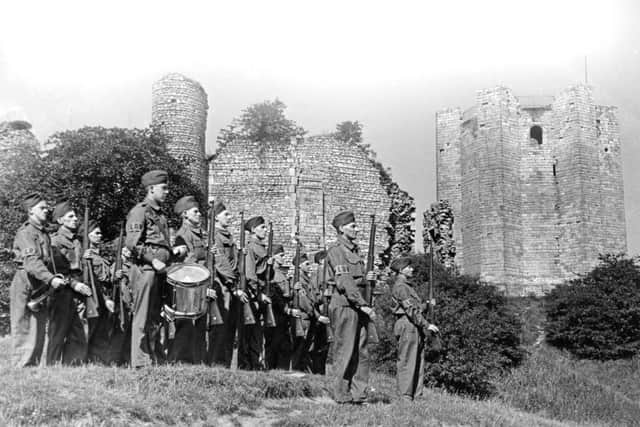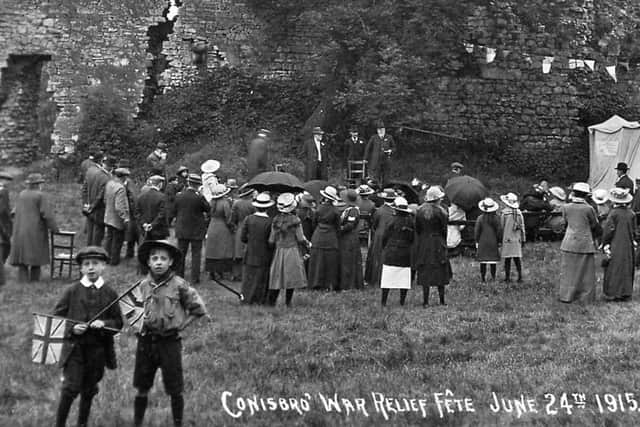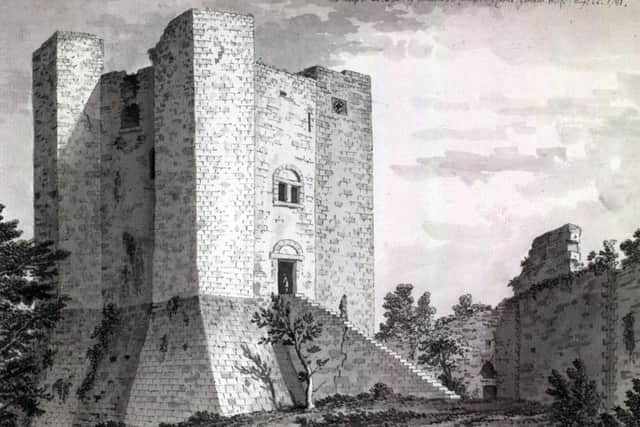Keep Soldiering On


Conisbrough was formerly titled Cyningesburgh – Anglo Saxon for ‘King’s borough’. Before the Conquest, Conisbrough was an important area, with the Anglian church of St Peter established there around the 8th century. The church is the oldest standing building in South Yorkshire.
It has also been suggested Conisbrough might have been a royal estate and minster of the Anglian Kings of Northumbria. The Domesday Book records that before the Norman Conquest the area was in the hands of King Harold.
Advertisement
Hide AdAdvertisement
Hide AdAfter 1066, William the Conqueror gave the honour of Conisbrough to one of his proven companions, William de Warenne, in recognition of the significant part played in the Battle of Hastings. De Warenne married William’s stepdaughter, Gunreda. He was also created first Earl of Surrey.


The Domesday Book records his lands extended over thirteen counties and included manors in Norfolk, Suffolk and Essex. The Warenne family’s principal English seat was Lewes in Sussex.
The first castle at Conisbrough probably consisted of earthworks, a timber palisade, a small wooden tower and hall enclosure topped with timber buildings. This was on the site of the existing bailey.
In 1163, Isabel, widow of the fourth earl of Surrey, married Hamelin Plantagenet, illegitimate brother of King Henry II. Hamelin subsequently took the arms of de Warenne and became the fifth Earl of Surrey.
Advertisement
Hide AdAdvertisement
Hide AdThe present stone Keep was almost certainly built by Hamelin de Warenne (Plantagenet) and was completed between 1170 and 1190. Built of fine ashlar, its plan is unique in Britain. Standing about 90ft in height, with six boldly projecting buttresses, the structure is basically circular with a strongly splayed base, 62ft in diameter. The thickness of the walls above the splayed base is 15ft.


The closest parallel to the Conisbrough Keep is found at Mortemer, near Dieppe in France, a castle also held by the Warenne family.
The Keep was where the Lord and Lady stayed when visiting the Castle. It housed the lord’s most private rooms where he met with important guests and discussed business. The top floor was a bedroom chamber.
Surviving documents reveal that Hamelin and Isabel jointly founded an endowment for a priest within the castle. The small chapel of St Philip and St James was subsequently established on the second floor of the Keep.
Advertisement
Hide AdAdvertisement
Hide AdThe building of the stone curtain walls, and the buildings constructed against them, followed not long after the establishment of the Keep. The buildings included the Great Hall, Kitchen and Chamber Block. These were located in the Inner Bailey; the castle also comprised a Barbican and an Outer Bailey.


The Great Hall was the largest room and the centre of its public life. Hosting feasts, music and dancing, the Great Hall was also where power was exercised. In 1201, Hamelin’s nephew, King John (r.1199-1216), stayed at Conisbrough and on March 5 of that year gave a market charter to be held there one day a week.
Conisbrough Castle remained with the Warenne family until November 17, 1317. Lands owned by them in Yorkshire, including Conisbrough Castle, were seized by Thomas, Earl of Lancaster, during a rebellion. Thwarted at the Battle of Boroughbridge in 1322, Thomas was later executed and Conisbrough Castle taken over by Edward II. Repairs were carried out on the building’s walls and Keep and it was handed back to the Warenne family in 1326.
Leaving their ownership in the mid 14th century, the castle and lordship of Conisbrough passed through a number of hands until granted to the Crown in perpetuity in 1495.
Advertisement
Hide AdAdvertisement
Hide AdBy 1538, the curtain walls had fallen down and the Keep was abandoned. By the time of the English Civil War (1642-1651), the castle was of no use as a stronghold and so suffered no further damage.


The ruins drew artists in the 18th and 19th centuries and examples of their work may be seen here. They are from the Gott collection and reproduced courtesy of the Hepworth, Wakefield.
Ownership of the castle and manor passed to the Duke of Leeds in 1737 for £22,500. The romantic ruins inspired Sir Walter Scott’s novel Ivanhoe, published around 1820.
From 1859, the castle was owned by Sackville Lane Fox and thereafter the grounds became an important park.
Advertisement
Hide AdAdvertisement
Hide AdThe Ministry of Works (now English Heritage) bought the castle in 1949 and during the remainder of the 20th century and into the present one undertook consolidation and rebuilding work. During the 1970s, a stone staircase to the Keep was replaced by concrete steps, much to the indignation of locals and conservationists.
Archaeological excavations in this period found the remains of a fallen south wall and gate-house besides other fascinating artefacts.
In the early 1990s, a major decision was taken regarding the castle, which was now managed by the Ivanhoe Trust. Work started on a scheme to restore the roof and floors to the Keep and build a modern exhibition building. The latter’s design caused a major controversy.


On April 1, 1995, visitors saw for the first time in 450 years the Keep’s interior as Hamelin Plantagenet had intended.
Advertisement
Hide AdAdvertisement
Hide AdIn 2007, the castle reverted to direct management by English Heritage. Further renovation has taken place in recent years assisted by the Heritage Lottery Fund with a new visitors’ centre and visitor facilities provided.